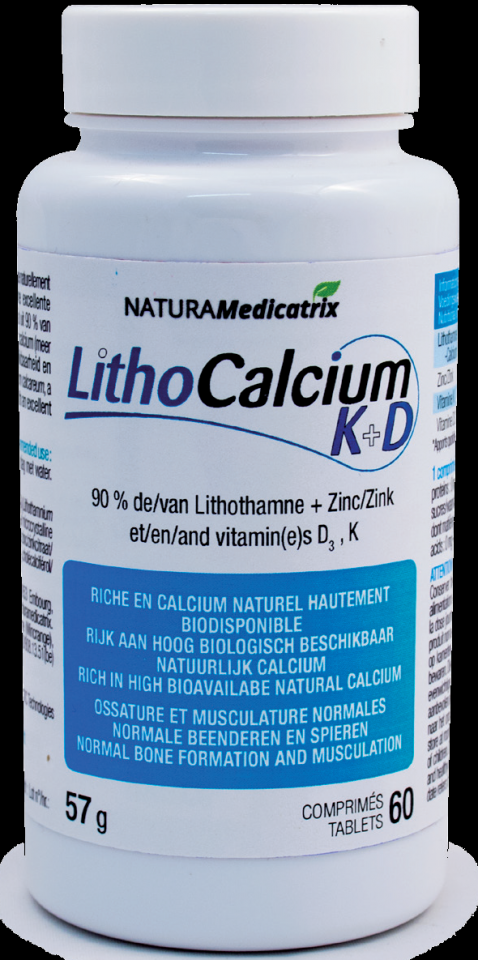LithoCalcium K+D
Lithothamne and organic calcium
Bones density & solidity
Vitamin D3
Healthy growth and remodeling of bones
Vitamin K
Bones formation
Zinc
Healthy and strong backbone
Osteoporosis, postmenopausal women, men and women over the age of 65 years.
OSTEOPOROSIS
According to the WHO, «osteoporosis is a generalized disease
of the skeleton, characterized by low bone density and
alterations in bone microarchitecture, causing exaggerated
bone fragility and therefore a high risk of fracture. These
fractures mainly affect the bones of the vertebrae, hips and
hands. Moreover, since osteoporosis remains asymptomatic
for very long time, spontaneous fractures without external
shock may be the first manifestation.
There are two types of osteoporosis. Primary osteoporosis
usually occurs in postmenopausal women due to a decrease
in estrogen secretion. Secondary osteoporosis
occurs in men and women over the age
of 65 years, but also can be induced in
young people by various diseases or by
the chronic use of certain drugs, such as
corticosteroids.
ETHIOLOGICAL FACTORS OF OSTEOPOROSIS MAY HAVE SEVERAL ORIGINS
Osteoporosis is most often a multifactorial disease. Even if
estrogen deficiency, secondary to menopause, plays a decisive
role, other factors must be taken into consideration.
Risk factors
Menopause
Genetics
Nutritional and environmental factors
Pathologies
Medications
Menopause
It is well established that primary osteoporosis in
postmenopausal women is linked to reduced estrogen status
leading to accelerated bone catabolism [1]. The incidence of
fractures varies considerably among countries, but on average
up to 50% of women over the age of 50 are at risk of fractures.
It is therefore a real public health problem because of the
aging population [2].
Genetics
It has long been known that daughters of osteoporotic mothers
have low bone mineral density (BMD). Recent advances have
been made in understanding the genetic basis of osteoporosis,
especially in menopausal women. Bone mineral density, size,
quality and remodeling are all influenced by genetic factors
that contribute to the development of osteoporosis. Several
candidates for the risk of osteoporosis have been identified [3,4].
Epidemiological studies suggest that up to 30 different genes
may be associated with the risk of developing osteoporosis
[5]. For example, in a study of 944 postmenopausal women
in Spain, a functional MTHFR Ala222 → Val polymorphism in
the gene encoding methylenetetrahydrofolate reductase
was significantly associated with an increased incidence of
vertebral fractures [6].
Nutritional and environmental factors
Poor nutrition and physical inactivity are risk factors for
the development of osteoporosis.
Indeed, feeding intervenes at all phases of bone life and is
one of the major determinants of the risk of fractures. Several
vitamins, minerals and trace elements are involved in bone
metabolism. Optimal intake of vitamin D, vitamin K and calcium
appears to be essential for the prevention of osteoporosis.
Adequate or optimized supplies of zinc, copper, magnesium
and manganese are also important.
Besides good food hygiene, physical exercise is also a
not insignificant factor to consider in the prevention of
osteoporosis. Physical activity primarily reduces bone
loss but also maintains muscle strength. However, exercise
programs for people with osteoporosis need to be carefully
planned in collaboration with a physician, because of the risk
of fracture.
Pathology
Among the conditions that can lead to osteoporosis are
hormonal disorders (hyperactivity of the thyroid gland or
parathyroid glands), rheumatoid arthritis, certain tumors, or
severe diseases of the intestine, kidneys or Liver.
Medications
Some treatments, such as high doses of cortisone, cause
bone loss leading to long-term osteoporosis. In addition,
the increasing use of thiazolidinediones (TZD), aromatase
inhibitors (AI), and other drugs or treatments are
also associated with the onset of secondary osteoporosis.
offers a unique
combination of the most
important nutrients
GOOD NUTRIENTS TO MAINTAIN SAFE AND STRONG FOUNDATIONS
Nutritional composition Per day (2 tablets)
Lithothamne
- natural organic calcium source
Zinc
Vitamin K
Vitamin D3
Usage tips
2 tablets daily with water.
Store at room temperature in a dry place.
